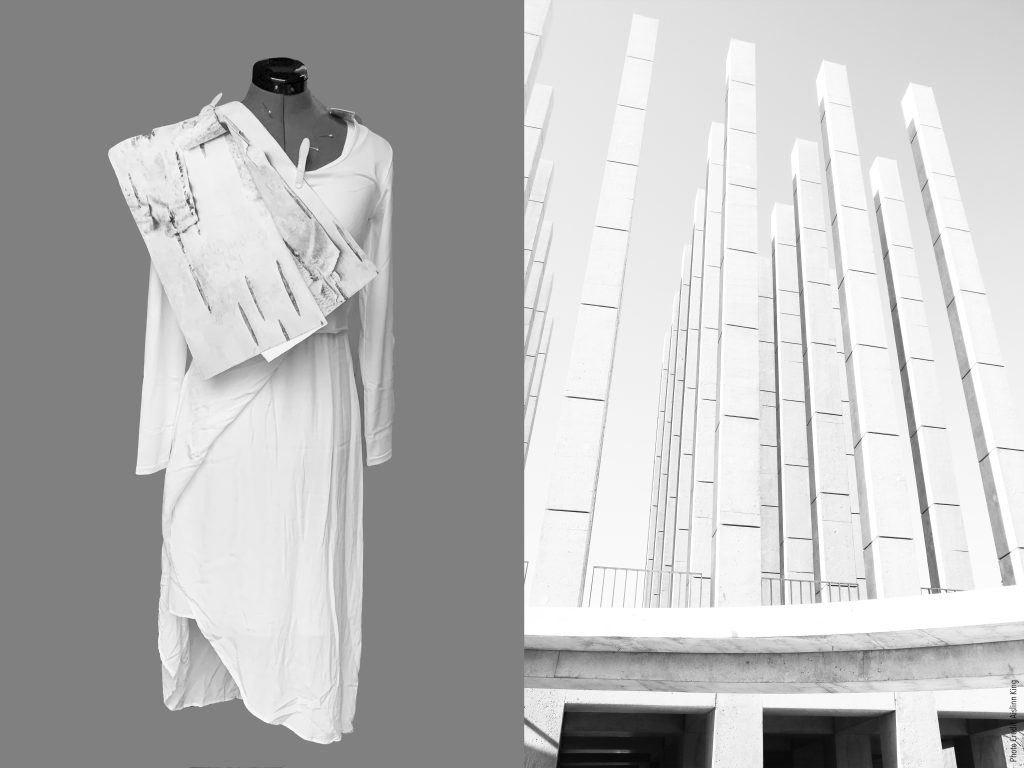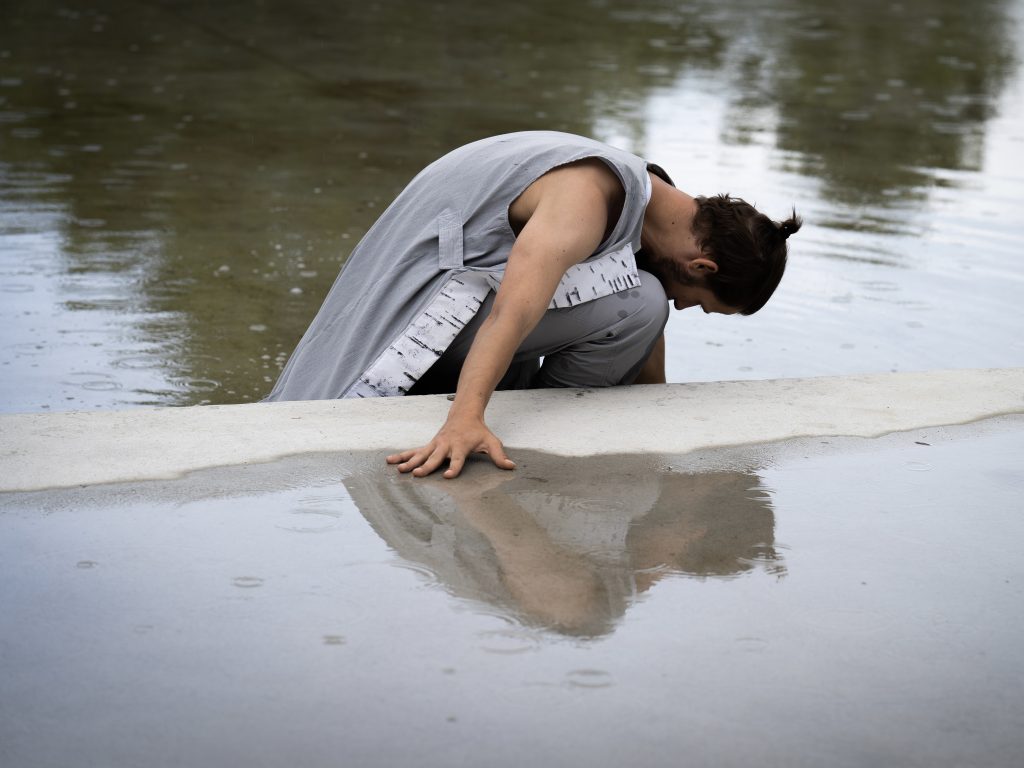Aislinn King
Design Approach
Within my design practice I am drawn to creating immersive experiences inspired by movement, gesture, light and material exploration.
My recent projects explore embedding conceptual, haptic and embodied modes of design in to the development, collaboration and realisation of a performance piece.
My experience of performance contexts in other places has enabled this thinking to continue to evolve, particularly with time in Denmark as part of the 2020 MADE by the Opera House Scholarship Exchange design workshops and master classes, and most recently as a selected exhibiter at World Stage Design 2022 in Calgary, Canada, engaging with performers and designers exploring innovative modes of interpretation and staging.
The APDG Emerging Designer for Live Performance Award I received in 2022 was for a production that explored the notion of one continuous line of spatial threshold for a newly written text and I am appreciative of this support from the APDG as an emerging designer now transitioning to the professional realm.
I commenced my studies in design for performance at NIDA in 2016 and continued on to the masters program in 2019, completing my practice led research on tacit knowledge, and graduating in 2020 with a Masters of Fine Arts in Design for Performance.
The projects featured below highlight some of this evolving thinking towards a sensibility of lightness, transition and gesture.
AISLINN KING

Design Concept: LESS
Image 1: Embodied design process. Aislinn King with developed LESS costume pieces in testing. Photograph by Peter King.
Image 2: Design correlations to the site-specific context. Photograph by Aislinn King.
Image 3: LESS in performance. Dancer Levente Szabo. Australian Dance Party. Costume Design Aislinn King. Photograph by Olivia Fyfe.
Image 4: LESS in performance. Dancers Levente Szabo, Jake Silvestro, Ashlee Bye and Patricia Hayes-Cavanagh. Australian Dance Party. Costume Design Aislinn King. Photograph by Olivia Fyfe.
LESS was a site-specific performance created and performed by the Australian Dance Party and collaborating dance artists and musicians, within the architectural LESS Pavilion at Dairy Road, Fyshwick, across 12 performances in March 2022.
Through an embodied design approach, the costumes emerged as a medium to translate and connect the contextual and interpretive qualities of the performance.
Within the immense scale of the concrete columns, the performers’ scale and ephemerality is emphasised in contrasting white costume elements. The sense of ruin and of ancient, monolithic places that the LESS Pavilion evokes, inspired a reductive approach to the costume elements with hints of remnant silhouettes and rituals.
In response to the architects’ intention for the pavilion to ‘return to nature’ through weathering and deterioration of the concrete over time, I created a series of photographic imprints capturing markings and abstract lines that relate to the linearity and seams within the pavilion form.
LESS situated the audience amidst dancers and musicians interacting with an architectural pavilion in many different conditions of light, air, rain and water. The audience was immersed from the onset, sitting on a shallow plane of water and many intuitively found connection to the site and performance through removing their shoes.
With the dancers’ movements in the plane of water the layers of grey costume started to reveal water markings in the same way that the concrete columns become temporarily stained in water.
LESS was part of the 2022 Enlighten Festival and the Bold Festival, an illuminated outdoor dance and music performance. LESS was directed by Alison Plevey in collaboration with dancers Ryan Stone, Ashlee Bye, Levente Szabo, Jake Silvestro,
Patricia Hayes-Cavanagh and Gabriel Sinclair. Sound design was by Alex Voorhoeve with live instrumentation by Liam Budge (vocals) and John Mackey (sax). Lighting design was by Ove Mcleod. I collaborated closely from the onset with Alison and the performers to create a shared interpretation of the LESS Pavilion for the performance LESS.
The Chilean Architects of the LESS pavilion, Pezo Von Ellrichshausen, were commissioned by the Molonglo Group in Canberra as part of their transformation of an abandoned industrial area of warehouses that intriguingly adjoins a natural wetland extending from the Molonglo River.
Design Concept: Little Girls Alone In The Woods
Image 1: Little Girls Alone In The Woods in performance. Canberra Youth Theatre. Set design Aislinn King. Photograph by Sam Kennedy-Hine.
Image 2: Skeletal frame design detail. Set design Aislinn King. Photograph Ann Cleary.
Little Girls Alone In The Woods was a production created by the Canberra Youth Theatre at the Canberra Theatre’s Courtyard Studio, performed in May 2021.
The set design for Little Girls Alone In The Woods explored the notion of boundary and threshold expressed through the rawness and intensity of a steel grate structure, its permeable quality engaging with perceptions of what is beyond and what is within.
My design intent for this specific performance text was to create a stage set that offered interactive and haptic opportunities for the performers while also evoking a conceptual, imaginative reading of the spatial limits and setting the tone for the performance. While the steel grate material in its ubiquitous industrial context such as carparks and walkways is robust and utilitarian, I was drawn to its temporal and transformative qualities that are revealed through shifts in light, movement and sound.
Throughout early conceptual discussions with the director Luke Rogers, we placed focus on the spatial relationship between the two groups of performers within the play and the qualities and distinctions of their performance zones.
I worked closely with lighting designer Antony Hateley to draw out the qualities of the metal grate material to amplify the performance impact and atmosphere. Through light, the set transformed and responded to the dynamic and shifting energy of the performance.
The realisation of this steel set design was made with the invaluable collaboration of steel fabricator Renrow Steel, who worked with me to test and transform the raw industrial material in to the resolved assemblage of the set. It enabled an exploration of scale and fineness in evoking the intent and context of the performance.
Design Concept: Two Twenty Somethings Decide Never To Be Stressed About Anything Ever Again Ever.
Image 1: Two Twenty Somethings… set bump in with Renrow Steel in Canberra Theatre Courtyard Studio. Canberra Youth Theatre. Set design Aislinn King. Photograph Aislinn King.
Image 2: Two Twenty Somethings… in performance with cast Martha Russell, Elliot Cleaves and Blue Hyslop. Canberra Youth Theatre. Set design Aislinn King. Photograph Aislinn King.
Image 3: Two Twenty Somethings… set bump out with Renrow Steel in Canberra Theatre Courtyard Studio. Canberra Youth Theatre. Set design Aislinn King. Photograph Peter King and Aislinn King.
Two Twenty Somethings Decide Never To Be Stressed About Anything Ever Again. Ever. was a production created by the Canberra Youth Theatre at the Canberra Theatre’s Courtyard Studio, performed in December 2021.
The design for Two Twenty Somethings Decide Never To Be Stressed About Anything Ever Again. Ever. revealed an amplified millennial construct. The set held the spaces within the notional apartment through the concept of a skeletal frame, starting with the outline of a doorway and following a singular line to shape each of the zones of interaction. The open frame delineated threshold and limit in a manner that was transitional and illusive.
Two Twenty Somethings… has a distinct comedic style, the bright yellow of the frame emerged as a way to express the tone and vibrancy of the performance in a distinct way, as well as relate to the millennial colour palette of pink and yellow that I carried across into the props and costumes to set the context for the performance.
In distilling the frame of the apartment to one singular line that expressed the architecture of the spaces, the way these lines were detailed and interconnected became intrinsic to the design. I developed the early design renders of the set as a 3D model in Rhino to work out the complexity of the line as it folded and turned in three directions. This enabled a three-dimensional portrayal of the spaces in which each scene could be specifically set and yet all part of the continuous frame. Through the skeletal frame I hoped to create a singular strength of gesture to delineate implied spaces that could be understood by the audience yet gave scope for imagination.
The precision of the skeletal frame was created with the support and skill of Renrow Steel. I collaborated with Amanda Marshall, the director of Renrow Steel, to resolve the welding and assemblage details. The set was prefabricated in sections for transport and handling, assembled onsite in the theatre venue. The translation of the design concept into realisation was made possible by the shared sensibility.
For further detail and full production credits please also refer to website: https://aislinnking.com/








